北师大版(2019)选择性必修第三册Unit 9 Human Biology Lesson 3 Epidemics Explained 课件(共35张PPT)
文档属性
| 名称 | 北师大版(2019)选择性必修第三册Unit 9 Human Biology Lesson 3 Epidemics Explained 课件(共35张PPT) | 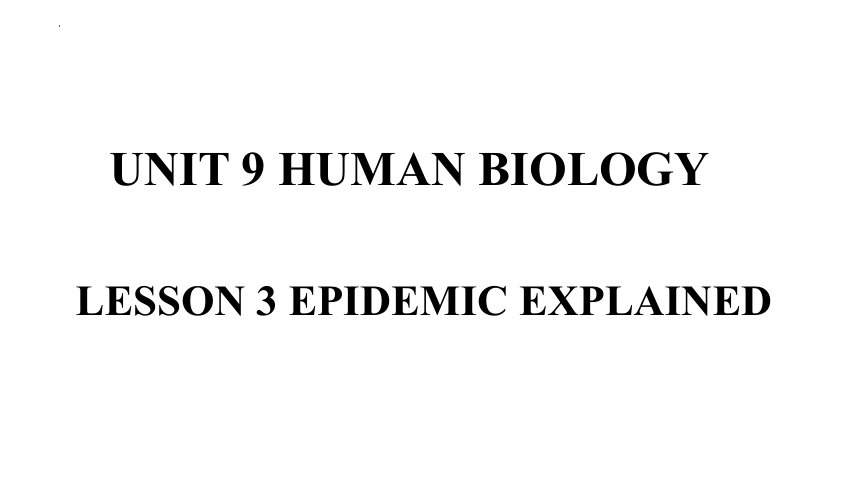 | |
| 格式 | pptx | ||
| 文件大小 | 834.4KB | ||
| 资源类型 | 教案 | ||
| 版本资源 | 北师大版(2019) | ||
| 科目 | 英语 | ||
| 更新时间 | 2024-07-14 11:14:24 | ||
图片预览

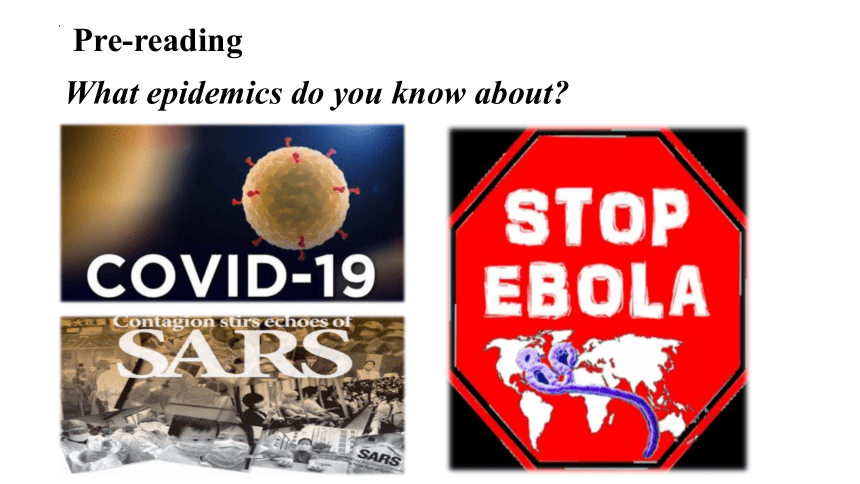


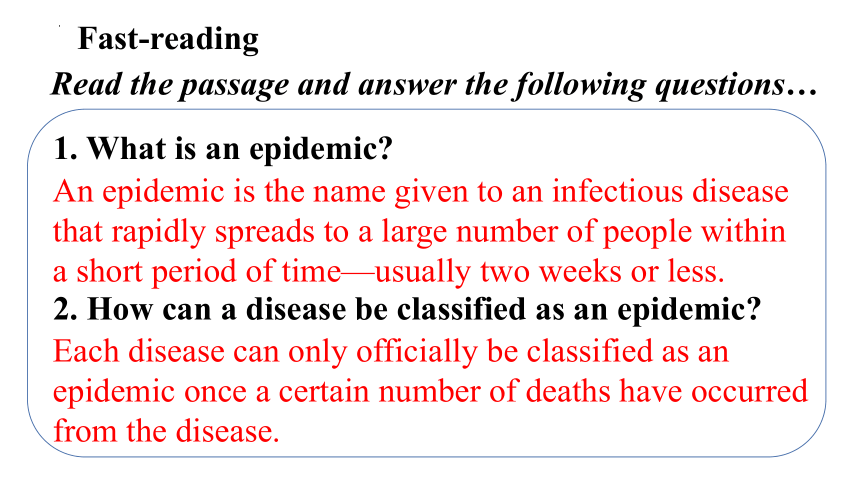
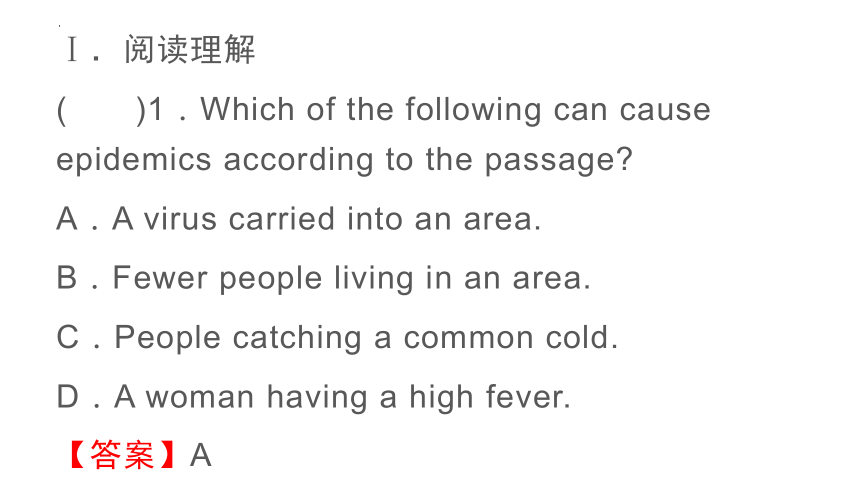


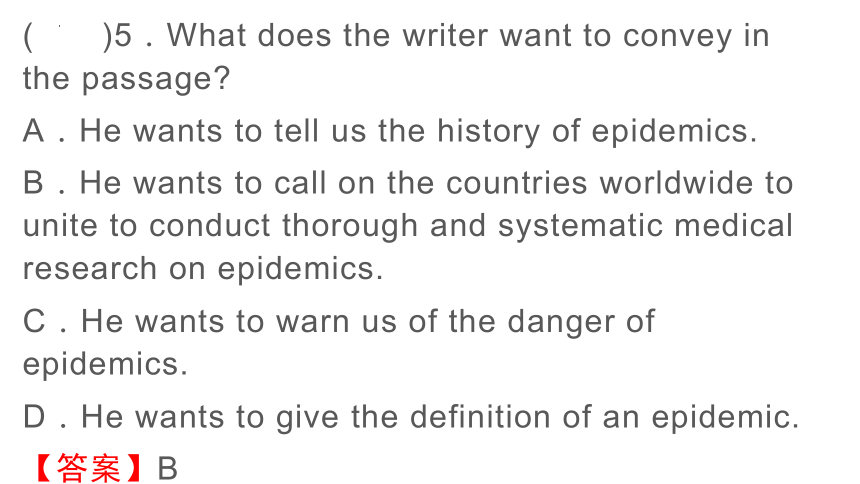
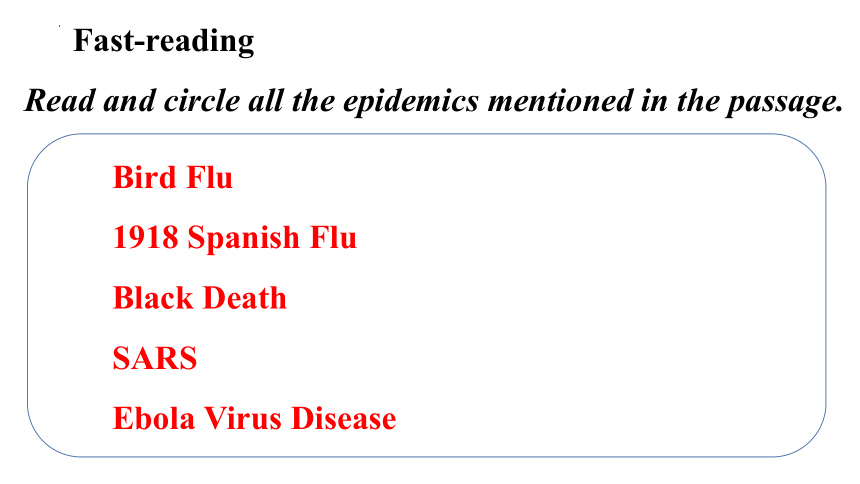
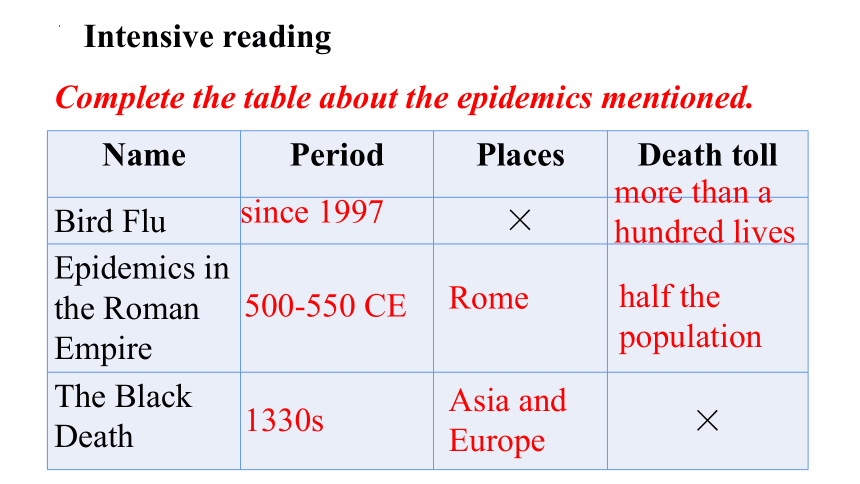
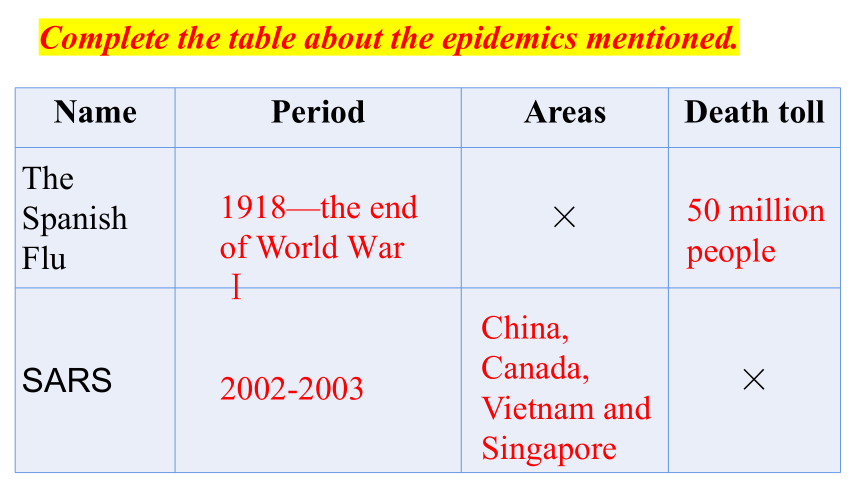
文档简介
(共35张PPT)
LESSON 3 EPIDEMIC EXPLAINED
UNIT 9 HUMAN BIOLOGY
Pre-reading
What epidemics do you know about
What do you know about epidemics Tick ( ) the statements that you think are correct.
An epidemic is the rapid spread of an infectious disease.
An epidemic can affect a large number of people in a given population.
An epidemic can occur within a short period of time, usually two weeks or less.
Pre-reading
What do you know about epidemics Tick ( ) the statements that you think are correct.
An epidemic may spread to several countries or continents.
Some common viruses, such as the common cold, are not epidemics.
A new epidemic can be a different variation of a virus that people caught in the past.
Pre-reading
1. What is an epidemic
2. How can a disease be classified as an epidemic
An epidemic is the name given to an infectious disease that rapidly spreads to a large number of people within a short period of time—usually two weeks or less.
Fast-reading
Each disease can only officially be classified as an epidemic once a certain number of deaths have occurred from the disease.
Read the passage and answer the following questions…
Ⅰ.阅读理解
( )1.Which of the following can cause epidemics according to the passage
A.A virus carried into an area.
B.Fewer people living in an area.
C.People catching a common cold.
D.A woman having a high fever.
【答案】A
( )2.What can we know about bird flu according to Paragraph Four
A.It first appeared in 1987.
B.It has taken over one thousand lives.
C.It is a modern adaptation of the 1918 Spanish Flu.
D.People don’t worry that it could be the next global epidemic.
【答案】C
( )3.What is the visible symptom of The Black Death
A.The eyes become terribly red.
B.The body has black spots.
C.People have a high fever. D.People cough a lot.
【答案】B
( )4.Which of the following epidemics is believed to have been the most severe in history
A.The SARS.B.The Ebola Virus Disease.
C.The bird flu.D.The Spanish Flu.
【答案】D
( )5.What does the writer want to convey in the passage
A.He wants to tell us the history of epidemics.
B.He wants to call on the countries worldwide to unite to conduct thorough and systematic medical research on epidemics.
C.He wants to warn us of the danger of epidemics.
D.He wants to give the definition of an epidemic.
【答案】B
Fast-reading
Bird Flu
1918 Spanish Flu
Black Death
SARS
Ebola Virus Disease
Read and circle all the epidemics mentioned in the passage.
Intensive reading
Name Period Places Death toll
Bird Flu ×
Epidemics in the Roman Empire
The Black Death ×
Complete the table about the epidemics mentioned.
since 1997
500-550 CE
1330s
Rome
Asia and Europe
more than a hundred lives
half the population
Name Period Areas Death toll
The Spanish Flu ×
SARS ×
Complete the table about the epidemics mentioned.
1918—the end of World War Ⅰ
2002-2003
China, Canada, Vietnam and Singapore
50 million people
Intensive reading
Name Period Areas Death toll
EVD
Complete the table about the epidemics mentioned.
2013-2016
West Africa
more than 11,310 death
Intensive reading
when epidemic started
examples of epidemics
treatments
baseline number of deaths of epidemics
Tick the aspects that mentioned in the passage. Use a diagram to demonstrate in a logical way how they are organised.
definition
when it ended
possible causes of epidemics
possible solutions
Epidemics
when epidemic started
definition
when it ended
examples of epidemics
baseline number of deaths of epidemics
what
How to classify
Intensive reading
Post-reading
1. What are the main features of an epidemic Give at least two examples to illustrate your points.
2. What should different countries do to prevent outbreaks of epidemics in the future Why
3. What does the title mean to you What does the writer want to convey in the passage
4. What do you think the passage is written for
Discuss the questions.
Post-reading
1. What are the main features of an epidemic Give at least two examples to illustrate your points.
Discuss the questions.
The main features of an epidemic: (1) it is an infectious disease (2) it spreads rapidly to a large number of people within a short period of time (3) a certain number of deaths have occurred from the disease. The common cold is not an epidemic because while it affects many people, it does not cause deaths. SARS affected many people and caused many deaths, so it is considered an epidemic.
Post-reading
2. What should different countries do to prevent outbreaks of epidemics in the future Why
Discuss the questions.
Countries will need to work together to do this because teamwork among nations across the globe can save lives. This is a good example of building a community with shared future for mankind.
Post-reading
3. What does the title mean to you What does the writer want to convey in the passage
Discuss the questions.
The title means that the passage will explain questions about epidemics. The author wants to convey the information that we are always on our way to find an explanation to epidemics so as to find cure. It also implies that epidemics occurred naturally and inevitably. We can only explain it, and cannot prevent it or stop it completely now.
Post-reading
4. What do you think the passage is written for
Discuss the questions.
This is a popular science article. It is more likely to be written for people who are interested in this topic or who have a lot of questions or misunderstanding of epidemics.
◇词汇拓讲
1.variation n. 变化物,变体;差异,变动
(P58)A new epidemic can be a different variation of a virus that people caught in the past.
vary vi. 变化 various adj. 各种各样的
vary from…to… 从……到……变化
vary with… 随着……变化
vary in… 在……方面不同
variety n. 种类;多样性
a variety of=varieties of各种各样的
◇词汇拓讲
2.opposed adj. 与某事物相反;反对某事物,不赞成某事物
(P58)…as opposed to more common diseases, such as the flu, that have a higher baseline.
be opposed to (doing) sth. 反对(做)某事
as opposed to… 与……相反;而
oppose vt. 反对,不赞成 oppose (doing) sth. 反对(做)某事
opposite adj. 相反的;相对的 n. 反义词;对立面
prep. 在……对面 adv. 在对面
◇词汇拓讲
3.depressing adj. 令人沮丧的,让人忧愁的
(P58)…Jim Smith looks at the sometimes depressing history of epidemics for clues about how we can create a more positive future without epidemics.
depress vt. 使沮丧;使抑郁
depressed adj. 沮丧的;抑郁的
be depressed about… 对……感到沮丧
depression n. 沮丧;抑郁
◇词汇拓讲
4.actual adj. 实际的,真实的
(P59)11,310 deaths were officially recorded, but the actual number of deaths is probably much higher.
in actual fact事实上,实际上
actually adv. 事实上,实际上
“事实上,实际上”的其他表达方式:in fact; in reality; in effect; as a matter of fact等。
◇词汇拓讲
5.get over克服;战胜
(P59)The virus was extremely infectious and the survival rate was as low as 30% in some areas, indicating that very few people got over it.
get through通过(考试);(电话)接通;完成;熬过
get on/along with… 与……相处;进展
get down to (doing) sth. 着手(做)某事
◇词汇拓讲
6.globe n. 地球,世界;地球仪
(P59) Countries will need to work together to do this because teamwork among nations across the globe can save lives.
across the globe世界各地 global adj. 全球的
global warming全球变暖 globally adv. 全球地;世界上
1.(P58)With recent press reports drawing parallels between bird flu and killer epidemics of the past, Jim Smith looks at the sometimes depressing history of epidemics for clues about how we can create a more positive future without epidemics.
句中“With recent press reports drawing…”为with的复合结构,“recent press reports”作with的宾语,drawing作宾语补足语。介词with的复合结构中,宾语由名词或代词充当,宾语补足语由形容词、副词、介词短语、动词不定式或分词充当。
◇句式解读
(1)with+宾语+doing(doing表主动或正在进行的动作)
With spring drawing near, trees turn green.
(2)with+宾语+to do(to do表示将来的动作)
With a lot of problems to solve, the president is having a hard time.
(3)with+宾语+done(done表被动或已完成的动作)
He went to sleep happily with his tasks finished.
(4)with+宾语+介词短语/adj. /adv.
He was so tired that he fell asleep with the light on.
2.(P59)Having killed up to 50 million people in 18 months, the Spanish Flu is believed to have been the most severe epidemic in history.
本句中be believed to have done意为“被认为已经做了某事”。
sb. /sth. is believed to have done可以替换为It is believed that sb. /sth. did sth.
类似用法的还有:
It is said/reported that…=sb. /sth. be said/reported to do sth.
一、动词短语的概念
英语中有些动词可以和一些别的词构成短语,表达一个概念,其作用与一个单独的动词差不多,这种形式的组合,我们称为动词短语。例如:
leave off=stop停止
make out=understand理解
ring up=telephone打电话
arrive at=reach到达
□动词短语
二、动词短语的构成
1.“动词+副词”,这种结构在英语中使用十分广泛,如果后面接代词作宾语时,只能放在动词和副词之间;如果接名词,可以放在动词和副词之间,也可以放在他们的后面。常见的有:put up, bring up, set up, go up等。
Please put up the picture on the wall.请把画贴在墙上。
He put on the coat, turned off the light and went to see a movie.他穿上大衣、关上灯去看电影了。
2.“动词+介词”,其后可以跟名词、代词、动名词等。常见的有:look after, take after, care for, care about, look for, look at, arrive at, run into, break into, listen to等。
She is a volunteer. She is looking after the sick kid in the hospital.
她是个志愿者,她正在医院里照看那个生病的孩子。
Some robbers broke into a store and took away all the money.
几个强盗闯进了一家商店,拿走了所有的钱。
3.“动词+副词+介词”,常见的有:look down upon/on, look up to, come up with, put up with, do away with, break away from, look forward to等。
They look forward to visiting Paris.
他们盼望着参观巴黎。
We should respect others and never look down on them with their jobs, or disabilities.
我们应该尊重他人,永远不要因为他们的工作或身体残疾而看不起他们。
4.“动词+名词+介词”,常见的有:take care of, pay attention to, put an end to, give rise to, have a look at等。
Please take care of my dog when I leave for Beijing.
我动身到北京去时,请照看我的小狗。
Pay attention to your pronunciation, please.
请注意你的发音。
Homework
Search online and find some information about epidemics in China of Asia. Report your information to the class.
LESSON 3 EPIDEMIC EXPLAINED
UNIT 9 HUMAN BIOLOGY
Pre-reading
What epidemics do you know about
What do you know about epidemics Tick ( ) the statements that you think are correct.
An epidemic is the rapid spread of an infectious disease.
An epidemic can affect a large number of people in a given population.
An epidemic can occur within a short period of time, usually two weeks or less.
Pre-reading
What do you know about epidemics Tick ( ) the statements that you think are correct.
An epidemic may spread to several countries or continents.
Some common viruses, such as the common cold, are not epidemics.
A new epidemic can be a different variation of a virus that people caught in the past.
Pre-reading
1. What is an epidemic
2. How can a disease be classified as an epidemic
An epidemic is the name given to an infectious disease that rapidly spreads to a large number of people within a short period of time—usually two weeks or less.
Fast-reading
Each disease can only officially be classified as an epidemic once a certain number of deaths have occurred from the disease.
Read the passage and answer the following questions…
Ⅰ.阅读理解
( )1.Which of the following can cause epidemics according to the passage
A.A virus carried into an area.
B.Fewer people living in an area.
C.People catching a common cold.
D.A woman having a high fever.
【答案】A
( )2.What can we know about bird flu according to Paragraph Four
A.It first appeared in 1987.
B.It has taken over one thousand lives.
C.It is a modern adaptation of the 1918 Spanish Flu.
D.People don’t worry that it could be the next global epidemic.
【答案】C
( )3.What is the visible symptom of The Black Death
A.The eyes become terribly red.
B.The body has black spots.
C.People have a high fever. D.People cough a lot.
【答案】B
( )4.Which of the following epidemics is believed to have been the most severe in history
A.The SARS.B.The Ebola Virus Disease.
C.The bird flu.D.The Spanish Flu.
【答案】D
( )5.What does the writer want to convey in the passage
A.He wants to tell us the history of epidemics.
B.He wants to call on the countries worldwide to unite to conduct thorough and systematic medical research on epidemics.
C.He wants to warn us of the danger of epidemics.
D.He wants to give the definition of an epidemic.
【答案】B
Fast-reading
Bird Flu
1918 Spanish Flu
Black Death
SARS
Ebola Virus Disease
Read and circle all the epidemics mentioned in the passage.
Intensive reading
Name Period Places Death toll
Bird Flu ×
Epidemics in the Roman Empire
The Black Death ×
Complete the table about the epidemics mentioned.
since 1997
500-550 CE
1330s
Rome
Asia and Europe
more than a hundred lives
half the population
Name Period Areas Death toll
The Spanish Flu ×
SARS ×
Complete the table about the epidemics mentioned.
1918—the end of World War Ⅰ
2002-2003
China, Canada, Vietnam and Singapore
50 million people
Intensive reading
Name Period Areas Death toll
EVD
Complete the table about the epidemics mentioned.
2013-2016
West Africa
more than 11,310 death
Intensive reading
when epidemic started
examples of epidemics
treatments
baseline number of deaths of epidemics
Tick the aspects that mentioned in the passage. Use a diagram to demonstrate in a logical way how they are organised.
definition
when it ended
possible causes of epidemics
possible solutions
Epidemics
when epidemic started
definition
when it ended
examples of epidemics
baseline number of deaths of epidemics
what
How to classify
Intensive reading
Post-reading
1. What are the main features of an epidemic Give at least two examples to illustrate your points.
2. What should different countries do to prevent outbreaks of epidemics in the future Why
3. What does the title mean to you What does the writer want to convey in the passage
4. What do you think the passage is written for
Discuss the questions.
Post-reading
1. What are the main features of an epidemic Give at least two examples to illustrate your points.
Discuss the questions.
The main features of an epidemic: (1) it is an infectious disease (2) it spreads rapidly to a large number of people within a short period of time (3) a certain number of deaths have occurred from the disease. The common cold is not an epidemic because while it affects many people, it does not cause deaths. SARS affected many people and caused many deaths, so it is considered an epidemic.
Post-reading
2. What should different countries do to prevent outbreaks of epidemics in the future Why
Discuss the questions.
Countries will need to work together to do this because teamwork among nations across the globe can save lives. This is a good example of building a community with shared future for mankind.
Post-reading
3. What does the title mean to you What does the writer want to convey in the passage
Discuss the questions.
The title means that the passage will explain questions about epidemics. The author wants to convey the information that we are always on our way to find an explanation to epidemics so as to find cure. It also implies that epidemics occurred naturally and inevitably. We can only explain it, and cannot prevent it or stop it completely now.
Post-reading
4. What do you think the passage is written for
Discuss the questions.
This is a popular science article. It is more likely to be written for people who are interested in this topic or who have a lot of questions or misunderstanding of epidemics.
◇词汇拓讲
1.variation n. 变化物,变体;差异,变动
(P58)A new epidemic can be a different variation of a virus that people caught in the past.
vary vi. 变化 various adj. 各种各样的
vary from…to… 从……到……变化
vary with… 随着……变化
vary in… 在……方面不同
variety n. 种类;多样性
a variety of=varieties of各种各样的
◇词汇拓讲
2.opposed adj. 与某事物相反;反对某事物,不赞成某事物
(P58)…as opposed to more common diseases, such as the flu, that have a higher baseline.
be opposed to (doing) sth. 反对(做)某事
as opposed to… 与……相反;而
oppose vt. 反对,不赞成 oppose (doing) sth. 反对(做)某事
opposite adj. 相反的;相对的 n. 反义词;对立面
prep. 在……对面 adv. 在对面
◇词汇拓讲
3.depressing adj. 令人沮丧的,让人忧愁的
(P58)…Jim Smith looks at the sometimes depressing history of epidemics for clues about how we can create a more positive future without epidemics.
depress vt. 使沮丧;使抑郁
depressed adj. 沮丧的;抑郁的
be depressed about… 对……感到沮丧
depression n. 沮丧;抑郁
◇词汇拓讲
4.actual adj. 实际的,真实的
(P59)11,310 deaths were officially recorded, but the actual number of deaths is probably much higher.
in actual fact事实上,实际上
actually adv. 事实上,实际上
“事实上,实际上”的其他表达方式:in fact; in reality; in effect; as a matter of fact等。
◇词汇拓讲
5.get over克服;战胜
(P59)The virus was extremely infectious and the survival rate was as low as 30% in some areas, indicating that very few people got over it.
get through通过(考试);(电话)接通;完成;熬过
get on/along with… 与……相处;进展
get down to (doing) sth. 着手(做)某事
◇词汇拓讲
6.globe n. 地球,世界;地球仪
(P59) Countries will need to work together to do this because teamwork among nations across the globe can save lives.
across the globe世界各地 global adj. 全球的
global warming全球变暖 globally adv. 全球地;世界上
1.(P58)With recent press reports drawing parallels between bird flu and killer epidemics of the past, Jim Smith looks at the sometimes depressing history of epidemics for clues about how we can create a more positive future without epidemics.
句中“With recent press reports drawing…”为with的复合结构,“recent press reports”作with的宾语,drawing作宾语补足语。介词with的复合结构中,宾语由名词或代词充当,宾语补足语由形容词、副词、介词短语、动词不定式或分词充当。
◇句式解读
(1)with+宾语+doing(doing表主动或正在进行的动作)
With spring drawing near, trees turn green.
(2)with+宾语+to do(to do表示将来的动作)
With a lot of problems to solve, the president is having a hard time.
(3)with+宾语+done(done表被动或已完成的动作)
He went to sleep happily with his tasks finished.
(4)with+宾语+介词短语/adj. /adv.
He was so tired that he fell asleep with the light on.
2.(P59)Having killed up to 50 million people in 18 months, the Spanish Flu is believed to have been the most severe epidemic in history.
本句中be believed to have done意为“被认为已经做了某事”。
sb. /sth. is believed to have done可以替换为It is believed that sb. /sth. did sth.
类似用法的还有:
It is said/reported that…=sb. /sth. be said/reported to do sth.
一、动词短语的概念
英语中有些动词可以和一些别的词构成短语,表达一个概念,其作用与一个单独的动词差不多,这种形式的组合,我们称为动词短语。例如:
leave off=stop停止
make out=understand理解
ring up=telephone打电话
arrive at=reach到达
□动词短语
二、动词短语的构成
1.“动词+副词”,这种结构在英语中使用十分广泛,如果后面接代词作宾语时,只能放在动词和副词之间;如果接名词,可以放在动词和副词之间,也可以放在他们的后面。常见的有:put up, bring up, set up, go up等。
Please put up the picture on the wall.请把画贴在墙上。
He put on the coat, turned off the light and went to see a movie.他穿上大衣、关上灯去看电影了。
2.“动词+介词”,其后可以跟名词、代词、动名词等。常见的有:look after, take after, care for, care about, look for, look at, arrive at, run into, break into, listen to等。
She is a volunteer. She is looking after the sick kid in the hospital.
她是个志愿者,她正在医院里照看那个生病的孩子。
Some robbers broke into a store and took away all the money.
几个强盗闯进了一家商店,拿走了所有的钱。
3.“动词+副词+介词”,常见的有:look down upon/on, look up to, come up with, put up with, do away with, break away from, look forward to等。
They look forward to visiting Paris.
他们盼望着参观巴黎。
We should respect others and never look down on them with their jobs, or disabilities.
我们应该尊重他人,永远不要因为他们的工作或身体残疾而看不起他们。
4.“动词+名词+介词”,常见的有:take care of, pay attention to, put an end to, give rise to, have a look at等。
Please take care of my dog when I leave for Beijing.
我动身到北京去时,请照看我的小狗。
Pay attention to your pronunciation, please.
请注意你的发音。
Homework
Search online and find some information about epidemics in China of Asia. Report your information to the class.
